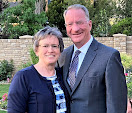“The Haitian Border: Missionary Crossing”
Elder Darrel L. Hammon
Tuesday, October 18, 2011
What a day today was! I was asked to help take the Haitian missionaries to Haiti to begin serving their missions there. They have been in the CCM for about three weeks. They all flew in, but for some reason, they couldn’t get tickets for all of them on the same flight back to Haiti. So, President and Sister Glazier, Elder McDermid and I, and Brother Cuevas and another brother took three vans with 12 missionaries to the Haitian border. On the way there, we took a northern, westerly route so we could pass by Lago Enriquillo, a salt-water lake, which runs close to the Haitian border. We passed through little communities like Glavan, Neyba, Villa Jaraqua, Las Clavellinas, Los Rios, Postrer Rio, Las Descubiertas, Boca de Cachón, y Jimani, the town closest to the border.
One the way, we passed plantation after plantation after plantation of banana trees. Bananas everywhere. Along side of the road in the little communities and outside of the communities were little stands, selling all sorts of bananas, guineos, and plantains. It was a sight to see. I told Elder McDermid, this is where we ought to buy our bananas. They are plentiful and fresh from the tree.
 |
| Las Caritas (the Little Faces) |
Also, along the way we stopped at Parque Nacional: Las Caritas near another park, el Parque Nacional: Parque Enriquillo. We climbed up to this cool overhang that had faces carved into the walls. Looking south, we could see Lago Enriquillo. It was definitely an incredible view. It was
quite steep but well worth the precarious climb and the ever-present heat and mugginess.
Outside of Boca de Cachón, we were supposed to drive along the lake. Unfortunately, the water level had risen to such a point as to cover the entire road. We had to go around and down a dirt road. Ironically, when we were passing through town, a young man tried to get us to turn down this other street. Brother Cuevas was in the lead van. We just thought he was trying to get us to turn on a different street from the one we were on. We thought he was just pointing to the other street so we could go to his negocio, his place of business. We continued on our merry way.
 |
| Lago Enriquillo |
Lo and behold, about two miles out, we encounter no road, just a lake. I guess the last time President Glazier came this way, which about three months ago, they just drove through the water, which was about six inches deep. Now, the road lay completely submerged in the water. There was no way we were going to drive through it. So, we turned around and headed back to town to get directions of where we needed to go—ironically down the same road the young man pointed to earlier.
 |
| The road not taken--too much lake on the road |
We rolled onto a dusty, old road purposely built, I suspect, so that everyone could go around the lake-covered road. When we were driving down the road, it seemed like something out of an old movie, driving down a dirt road, chasing bad guys although we weren’t chasing any bad guys, just trying to get to the Haitian border to drop off missionaries. It was incredible. Pretty soon, though, we were back on the main road.
Soon, the border loomed large. Everything looked old and run down and dismal. The buildings and shacks at the border crossing seemed haphazardly built and placed, definitely a sign of no zoning conversations whatsoever. Trucks still lined the roads. Off the road, though, sat dozens and dozens of truck trailers full of supplies and goods. Some of the doors were partially open, and we could see in. There were foodstuffs, just sitting in the trailers, probably waiting for more trucks to haul it across the borders. At least that is what I hope was happening.
We pulled up along side of a building. There was the Haitian mission president, President Joseph, waiting for us. The missionaries instantly perked up. There was their mission president, and they were ready to go. President Joseph is a young mission president, not more than 30-years old. What a challenge he has on his hands; yet, when I talked to him, he seemed up to the challenge.
We stopped. President Joseph took the missionaries to check in with the border crossing people. We waited in the cars. While we were waiting, we decided to eat our lunch. Brother McDermid had been nibbling on his the whole time. Soon, a young man came to the window, begging for food. Elder McDermid gave him some chips and a banana. Before too long, here came another young man. I looked over to Brother McDermid and said, “We don’t have enough food to share with all of these young men. In fact, we would never have enough food to share.”
Soon, the missionaries were back. They pulled their bags from the three vans and placed them in another big van. Initially, we were going to go across the border, drop off the missionaries, and then turn right around. But here was a van from nowhere to take the missionaries across.
 |
| At the Haitian border |
The farewell was both sad and happy. All of the missionaries hugged President and Sister Glazier, thankful for having known them. We took pictures, said our goodbyes, and off they went. Before we could all get back in our vans, they had already crossed into their country.
Sister Glazier told me that one of the missionaries said, “We are going to change our country.” I believe them. If anyone will change Haiti, it will have to happen from within. And these young men and two young women are capable, along with the other 50+ elders and sisters already serving in Haiti. I applaud them and raise my hands to them: “Shall we not go on in so great a cause? Courage, Brethren [Sisters] and on, on to the victory!”
I truly believe they are capable. They will change hundreds of lives while they serve their brothers and sisters. And there will be others who follow in their glorious footsteps. It may take many, many years, but slowly, person by person, family by family, they will change the people and their ways and bring them unto Christ. And thus it shall be.

















